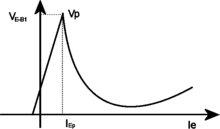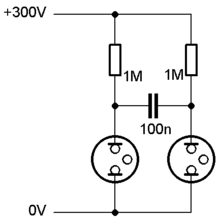Negativ differentiel modstand




En komponent eller et kredsløbs dynamiske modstand eller differentielle modstand er defineret ved: R(I)=dU/dI eller R(U)=dU/dI, hvor R er den dynamiske modstand ved hhv. strømmen I eller spændingen U, U er spændingen over komponenten og I er strømmen gennem komponenten.
Der findes simple komponenter, som har negativ differentiel modstand (NDR), på visse dele af deres modstandskarakteristik. Nogle af disse er tunneldiode, diac, Gunn diode, IMPATT-Diode, mikrobølge avalanchediode, resonanstunneldiode, unijunction-transistor (ujt), resonanstunneltransistor, plasma, lysbuer (f.eks. gasudladningsrør og dermed lysstofrør). [3] [4] [5] [6]
Selvom en komponent er ulinear og har negativ differentiel modstand, er den som regel i mindre strøm- og spændings-intervaller linear, hvilket betyder at den differentielle modstand i intervallet er konstant.
I netop et nogenlunde lineart interval med negativ differentiel modstand, kan komponenten forstærke signaler nogenlunde lineart. En af de simpleste eksempler er at sætte komponenten i serie med (lav NDR-impedans) eller parallelt over (høj NDR-impedans) en svingningskreds.
En NDR-komponent eller NDR-system i det rette kredsløb, kan fungere som en elektronisk forstærker - se kilder.[7][8]
Afhængig af om svingningskredsens samlede tab (inkl. evt. ekstern belastningsmodstand) delvis ophæves, netop ophæves eller mere end ophæves, så vil kredsløbet hhv. fungere som en afstemt forstærker, bibeholde en igangsat svingning eller fungerer som en oscillator.
Der findes også kredsløb, som udviser negativ differentiel modstand, på visse dele af deres modstandskarateristik. Nogle af disse er: Lambda-diode, gyrator, Negativ impedanskonverter (eng. Negative Impedance Converter) (NIC), Genereliseret impedanskonverter (eng. Generalized Impedance Converter) (GIC), Frekvensafhængig negativ modstand (eng. frequency-dependent negative resistor) (FDNR).
Anvendelse
Af anvendelser af negativ differentiel modstand er der f.eks. små radioantenner, superregenerativ modtager og NDR-oscillatorer. [9][10] [11] [12] [13] [14] [15] [16] [17] [18]
Her er et eksempel på at to komponenter (her glimlampe), som udviser negativ differentiel modstand, kan fungere som en astabil multivibrator. [19]
Kilder/referencer
- ^ americanradiohistory.com, Radio News, december 1932: Neon Tube Oscillators (pdf-side 26)
- ^ Video: Neon light oscillator circuit
- ^ en:Plasma channel
- ^ Maxim: APPLICATION NOTE 3528 CCFL Characteristics Arkiveret 30. oktober 2007 hos Wayback Machine Citat: "...Negative resistance can vary between individual lamps, causing the lamps to have different currents at any particular voltage level..."
- ^ McGraw-Hill's AccessScience: Arc discharge Citat: "...The arc has negative resistance-the voltage drop decreases as the current increase..."
- ^ rfcafe.com: Negative Resistance: What It Is & How It's Used. May 1961 Electronics World Citat: "...Negative-resistance devices have been with us long before the tunnel diode. Here are descriptions of some of them, along with how and why they operate...Negative-Resistance Devices...", backup
- ^ C. T. Munsterman. Tunnel-Diode Microwave Amplifiers, backup
- ^ Aertech Industries, Brooke Clarke: Tunnel Diode Amplifiers Citat: "...The TD amplifier combines a TD operating in the negative resistance region with a matching circuit and a circulator to separate the incident and reflected waves. Since the isolation of a single junction circulator is around 20 dB the gain of each stage needs to be less than that to prevent oscillations...", backup
- ^ G. W. Pickard, "How I Invented the Crystal Detector". Electrical Experimenter, vol. VII, no. 4, p. 325, Aug. 1919 Citat: "...In 1898, when my work in Radio-communication began, there was but one detector—the coherer...In the period 1902 to 1906, I tested many different minerals and combinations, including magnetite, pyrite, galena, molybdenite, silicon and zincite...Oscillating Crystal Detectors. The last word on crystal detectors and their uses has yet to be written. For example, it may be of interest to know that they can be made to OSCILLATE, under proper circuit conditions, and I have found it possible to receive intelligible signals from UNDAMPED wave stations across the Atlantic, on a simple contact between a fragment of galena and a fine wire...", backup
- ^ By Nyle Steiner K7NS 2001. Hjemmelavede dimser med negativ modstandskarakteristikker: Zinc Negative Resistance RF Amplifier for Crystal Sets and Regenerative Receivers Uses No Tubes or Transistors
- ^ God information om anvendelse af dimser med negativ modstandskarakteristikker, før de blev opdaget i tunneldioder i 1957: Cristadyne: Semiconductor archaeology or tribute to unknown precursors Arkiveret 17. marts 2013 hos Wayback Machine Citat: "...In 1923, Oleg Losev [O. V. Lossev, Lossew] (1903-1942) ( See link below ) managed to make a high frequency generator using such a detector. But it was polarized. This indicates that this diode had a characteristic curve in which a negative slope was present. And this makes one think of the tunnel effect diode invented a half a century later...These layouts where part of what one called CRYSTADYNE [eller Cristadyne, Crystodyne ] systems. But in those days, the technical performance and industrial ease of the new increasing valve technology made these layouts to be ignored, and then forgotten..."
- ^ The Wireless World and Radio Review. October 1, 1924 and October 8, 1924: "The Crystal As A Generator And Amplifier" by Victor Gabel.
- ^ earlyradiohistory.us: Radio News, September, 1924, pages 294-295, 431: The Crystodyne Principle Citat: "...SEVERAL experimenters have observed that some contacts, such as crystal and metal or crystal and carbon generally employed as detectors may produce undamped oscillations of any frequency, exactly as the vacuum tube oscillator. The same contact may also be utilized as an amplifier. Oscillating crystals are not new since they were investigated as far back as 1906 by well known engineers, but it was not until lately that a Russian engineer, Mr. O. V. Lossev, succeeded in finding some interesting uses for oscillating crystals..."
- ^ earlyradiohistory.us: Radio News, September, 1924, page 291: A Sensational Radio Invention By HUGO GERNSBACK Citat: "...Stated in a few words, the invention encompasses an oscillating crystal...In other words, THE CRYSTAL NOW ACTUALLY REPLACES THE VACUUM TUBE. That this is a revolutionary radio invention need be emphasized no further. [Her var Hugo Gernsback dog langt forud for sin tid]...We can not only detect with the crystal, but we can also amplify with it...we can now also transmit with the Crystodyne, and, as a matter of fact, a number of students in Russia have actually sent messages with such sets over distances of more than three-quarters of a mile during the past few months..."
- ^ beatriceco.com: Bell Labs – The Transistor – Other Claims to the Invention Arkiveret 21. december 2013 hos Wayback Machine Citat: "...This effect, he stated, was discovered by Dr W. H. Eccles in 1910, and remarked: “It is hard to realize that it took about ten years for practical active crystal-diode circuits to appear, in spite of Ditcham's reminder—circuits that included both RF and AF amplification...Most of the credit for creating practical devices [of this kind] goes to O. V. Lossev of Russia, whether or not he knew of Eccles' pioneer work a decade earlier..."
- ^ 'Energy-sucking' Radio Antennas, N. Tesla's Power Receiver Citat: "...The truth is quite strange...By manipulating the EM fields, we can force an electrically-small receiving antenna to behave as if it was very, VERY large...In theory a tiny loop antenna can work as well as a longwire 1/2-wave antenna which is 10KM long...The energy doesn't vanish, instead it ends up INSIDE the atom. By resonantly creating an "anti-wave", the tiny atom has "sucked energy" out of the enormously long light waves as they go by...When all is said and done, our oscillating coil has absorbed half of the incoming EM energy and re-emitted (or "scattered") the rest..."
- ^ C. F. Bohren, "How can a particle absorb more than the light incident on it?", Am J Phys, 51 #4, pp323 Apr 1983 Citat: "...A particle can indeed absorb more than the light incident on it...In the former, strong absorption is associated with excitation of surfaces plasmons; in the latter it is associated with excitation of surface phonons. In both instances, the target area a particle presents to incident light can be much greater than its geometrical cross-sectional area...."
- ^ Regeneration revisited. The Tesla Connection by Gary L. Peterson Citat: "...So it may be said that Tesla anticipated the technique of regenerative feedback to increase detector sensitivity...A detailed description of how the negative resistance, negative inductance circuit works, including a differential form of the active antenna circuit and other pertinent information, can be found in U.S. Patent No. 5,296,866, Mar. 22, 199..."
- ^ Neon Lamp Tricks! Neon Lamp Multivibrator Citat: "...This is an oscillator circuit using two neon lamps, two resistors, and one capacitor..."
- Matematisk orienteret: Jim Lesurf: Negative Resistance Oscillators
- God: Negative Resistance Revived. by Lloyd Butler VK5BR. (Condensed version of article originally published in Amateur Radio, November 1995) Arkiveret 3. august 2004 hos Wayback Machine
- The Negistor & Negative Resistance – 04/07/00 courtesy Marcelo Puhl Arkiveret 6. september 2006 hos Wayback Machine
 | Wikimedia Commons har medier relateret til: |
Medier brugt på denne side
(c) Zen-in at the English Wikipedia, CC BY-SA 3.0
8-12 GHz tunnel diode amplifier manufactured by Aertech, used in aerospace applications. This is a two-stage amplifier. Each stage consists of a reflection amplifier made of a biased negative resistance tunnel diode and a circulator, a three-port ferrite device that separates the output signal from the input, and matching networks. The input signal to each device is applied to port 1 at bottom of its heat sink, and is transferred to port 2 at right, connected to the tunnel diode mounted in the heat sink. The output from the tunnel diode emerges from port 3 at the top of the device. The circulator provides about 20dB isolation of the output from the input, so the gain of each stage must be limited below this value to prevent feedback, requiring 2 or more stages to achieve significant amplification. More information on these amplifiers is on Brooke Clarks Aertech website
Forfatter/Opretter: Д.Ильин: vectorization, Licens: CC0
Current-voltage characteristics or IV curves showing two types of negative differential resistance.
The left graph shows voltage controlled negative resistance (VCNR) also called N type. In this type the voltage is a multivalued function of current, but the current is a single-valued function of voltage. The graph is shaped vaguely like the letter N, with a voltage region with negative resistance between two positive resistance regions. Electronic devices with this type of negative resistance include the tunnel diode, Gunn diode, and vacuum tubes operating in the "dynatron" mode.
The right graph shows current controlled negative resistance (CCNR) also called S type. In this type the voltage is a multivalued function, while the current is a single-valued function. The graph is shaped vaguely like the letter S, with a region of current with negative resistance between to regions with positive resistance. Devices with this type of negative resistance include the IMPATT diode, unijunction transistor, SCR, and gas-discharge tubes like neon lamps and fluorescent tubes.Circuit of a Pearson-Anson oscillator, a very simple type of relaxation oscillator which uses a neon bulb as a switching device with hysteresis. The voltage source U charges capacitor C through resistor R. The neon bulb has a very high resistance until the capacitor voltage reaches its breakdown voltage Vbr, at which it conducts and discharges the capacitor, and the cycle repeats.
Forfatter/Opretter: Mkratz, Licens: CC BY-SA 3.0
Ionics - Symmetric astable multivibrator with neon bulbs - unit cell of File:Random Relaxation Oscillator with Neons.png
Forfatter/Opretter: Kormoran, Licens: CC BY-SA 3.0
The voltage-current curve of an UJT transistor.





